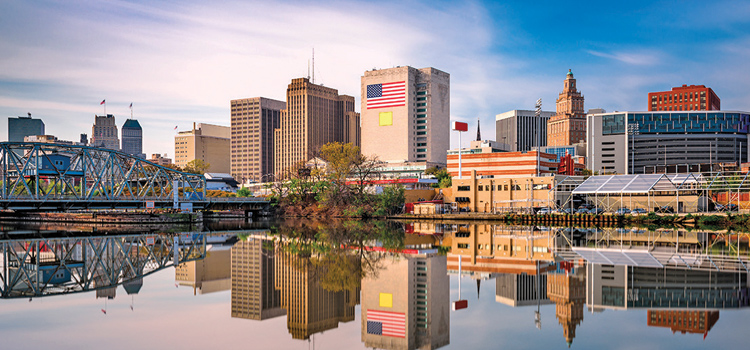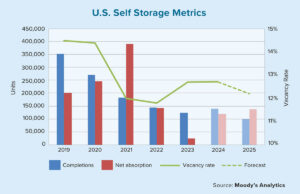New Jersey, New York and Pennsylvania each have rich histories that stretch back more than 350 years. Prior to signing the Declaration of Independence, they were commonly called the “breadbasket colonies” because rich soil in these areas supported an abundance of farms. They also were known for their diverse array of European immigrants and religious tolerance.
Today, the three states with a combined population of more than 40 million form the Mid-Atlantic Region. With a plethora of large cities in this region, the ongoing coronavirus pandemic has deeply impacted local economies. New York’s gross domestic product (GDP) decline of 8.2% from fourth-quarter 2019 to first-quarter 2020 matched Nevada’s for the largest in the nation, according to the U.S. Bureau of Economic Analysis. Pennsylvania’s and New Jersey’s GDPs shrank during that time by 5.6% and 5.5%, respectively, exceeding the national average of 5%.
 New York City struggled mightily in the early months of the health crisis. In May 2020, for example, unemployment rates in the five counties that encompass the city skyrocketed by 10 to 15 percentage points or more on an annual basis, according to labor statistics. In the 12 months ending in June 2020, the Big Apple shed about 777,000 jobs — a 16.6% decline — while the city’s usually robust leisure and hospitality sector lost 279,000 jobs, or 58.3% of its workforce.
New York City struggled mightily in the early months of the health crisis. In May 2020, for example, unemployment rates in the five counties that encompass the city skyrocketed by 10 to 15 percentage points or more on an annual basis, according to labor statistics. In the 12 months ending in June 2020, the Big Apple shed about 777,000 jobs — a 16.6% decline — while the city’s usually robust leisure and hospitality sector lost 279,000 jobs, or 58.3% of its workforce.
With some 6.1 million residents, Philadelphia is the eighth-largest metro area in the U.S. The city was flourishing prior to the COVID-19 outbreak, according to an April 2020 report from The Pew Charitable Trusts. In recent years, unemployment rates had dropped to historic lows, median household income was rising and the share of residents with a college education had grown.
New Jersey has more than 9,000 farms that generated more than $1 billion for the state in 2017. Agriculture is the state’s third-largest industry behind pharmaceuticals and tourism. Seventeen Fortune 500 companies are headquartered in New Jersey, including Johnson & Johnson, Prudential Financial, PBF Energy and Cognizant Technology Solutions.
Although U.S. News & World Report rated Pennsylvania No. 41 overall on its 2019 “Best States” list, it also ranked the Keystone State in the top half of states for opportunity and health care. According to the report, Pennsylvania is roughly in line with the national averages for cost of living and household income, while the state’s 7.4% share of adults without health insurance is about half the U.S. average.
The state of New York has an economy that is nearly the same size as Canada’s. New York ranks No. 1 nationally for yogurt production and No. 2 for apple production. The cities of Buffalo and Syracuse are ranked among the nation’s most-affordable housing markets.
Median home values in the Mid-Atlantic Region this past June ranged from about $198,000 in Pennsylvania to about $343,000 in New Jersey, according to Zillow. At that time, the median nationwide value of a house was $248,857, Zillow reported.
 New York’s housing market was on an upswing this past July, according to a report from the state’s Realtor association. Although for-sale inventory and closed transactions that month were down year over year by 21.3% and 26.5%, respectively, pending sales jumped by 40% annually and the median sales price rose 3.4% annually to $300,000.
New York’s housing market was on an upswing this past July, according to a report from the state’s Realtor association. Although for-sale inventory and closed transactions that month were down year over year by 21.3% and 26.5%, respectively, pending sales jumped by 40% annually and the median sales price rose 3.4% annually to $300,000.
New Jersey saw a 41% year-over-year decrease this past June in the number of home listings, state Realtors reported. The median sales price in New Jersey, however, rose 5.3% annually.
As of June 2020, Zillow reported that 9.3% of Pennsylvania homes had negative equity, while 1.3% of homes had delinquent mortgages. Each of these figures exceeded the U.S. averages of 8.2% and 1.1%, respectively.
Focus: Financial services
New York City is a global financial hub. Many of the largest U.S. banks — including JPMorgan Chase, Bank of America and Citigroup — are headquartered in the Big Apple, as well as numerous high-profile financial-technology companies such as Fundera, Venmo and Yieldstreet. Major banks headquartered in other parts of the Mid-Atlantic Region include Pittsburgh-based PNC Bank and Buffalo-based M&T Bank.
Labor statistics indicate that the financial-activities employment sector has taken a hit since the onset of the coronavirus pandemic. From June 2019 to June 2020, many of the region’s largest metros lost significant shares of these jobs, including New York City (down 6.5%), Newark (down 6.2%), Philadelphia (down 3.8%) and Buffalo (down 3.8%).
What the locals say
“I’m doing loans for people in Washington, D.C., New York, Los Angeles who have family or want to live in the Philadelphia area. They can now live here and just work from home, so you’re not really tied to live where you work anymore. That has been the biggest change I’ve seen [since the pandemic started]. And then we also have this Poconos region here as well, which has just taken off, too. It’s mountains, snowbirds, ski lodges and stuff like that. The Poconos area is blowing up.”

Jeremy Durkin
Senior mortgage consultant, Trident Mortgage Co.
3 Cities to Watch
Buffalo

New York’s second-largest city has a metro-area population of 1.1 million. Buffalo’s relatively low median household income of about $36,000 is accompanied by low homeownership costs (from 2014 to 2018, the median monthly mortgage payment was $967). The regional economy has grown by roughly 1% annually in recent years, although that’s about three times less than the U.S. average. And the number of unfilled jobs in the region is about 9% higher than the size of the workforce.
Newark

New Jersey’s largest city (population 282,000) is about 15 miles west of New York City. Newark’s seaport is the largest on the East Coast and the third largest in the U.S. Five area colleges and universities serve about 50,000 students. The city has a large renter population and its 7.8% annual home-price appreciation rate as of this past June bodes well for real estate investors. Newark’s median rent price also is considerably lower than neighboring markets, according to Zillow.
Pittsburgh

As the hub of western Pennsylvania, the Steel City is no longer reliant on steel manufacturing and is now investing in renewable energy, green buildings and transportation upgrades. The American Enterprise Institute Housing Center reported that, during a 10-week period this summer, Pittsburgh had one of the nation’s highest annual increases for purchase mortgage rate locks, a key indicator for pending sales transactions. The metro-area population is 2.3 million, although that number shrank for a seventh straight year in 2019.
Sources: American Enterprise Institute Housing Center; Built In NYC; Business Insider; Fortune; Khan Academy; LendingTree; Newark Alliance; New Jersey Department of Agriculture; New Jersey Realtors; New York State Association of Realtors; Pittsburgh City Paper; PublicSource; Statista; The Balance; The Buffalo News; The Pew Charitable Trusts; U.S. Bureau of Labor Statistics; U.S. Bureau of Economic Analysis; U.S. Census Bureau; U.S. News & World Report; World Population Review; Zillow






